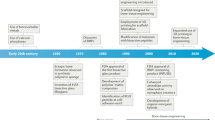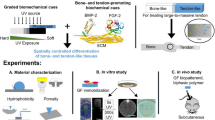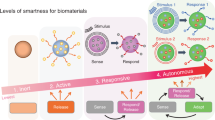Abstract
An important aim of regenerative medicine is to restore tissue function with implantable, laboratory-grown constructs that contain tissue-specific cells that replicate the function of their counterparts in the healthy native tissue. It remains unclear, however, whether cells used in bone regeneration applications produce a material that mimics the structural and compositional complexity of native bone. By applying multivariate analysis techniques to micro-Raman spectra of mineralized nodules formed in vitro, we reveal cell-source-dependent differences in interactions between multiple bone-like mineral environments. Although osteoblasts and adult stem cells exhibited bone-specific biological activities and created a material with many of the hallmarks of native bone, the ‘bone nodules’ formed from embryonic stem cells were an order of magnitude less stiff, and lacked the distinctive nanolevel architecture and complex biomolecular and mineral composition noted in the native tissue. Understanding the biological mechanisms of bone formation in vitro that contribute to cell-source-specific materials differences may facilitate the development of clinically successful engineered bone.
This is a preview of subscription content, access via your institution
Access options
Subscribe to this journal
Receive 12 print issues and online access
$259.00 per year
only $21.58 per issue
Buy this article
- Purchase on Springer Link
- Instant access to full article PDF
Prices may be subject to local taxes which are calculated during checkout






Similar content being viewed by others
References
Giannoudis, P. V., Dinopoulos, H. & Tsiridis, E. Bone substitutes: An update. Injury 36 (Suppl 3), S20–S27 (2005).
Friedlaender, G. E. Immune responses to osteochondral allografts. Current knowledge and future directions. Clin. Orthop. 174, 58–68 (1983).
Patel, R. & Trampuz, A. Infections transmitted through musculoskeletal-tissue allografts. N. Engl. J. Med. 350, 2544–2546 (2004).
Evans, M. J. & Kaufman, M. H. Establishment in culture of pluripotential cells from mouse embryos. Nature 292, 154–156 (1981).
Thomson, J. A. et al. Embryonic stem cell lines derived from human blastocysts. Science 282, 1145–1147 (1998).
Alper, J. Geron gets green light for human trial of ES cell-derived product. Nature Biotech. 27, 213–214 (2009).
Gruen, L. & Grabel, L. Concise review: Scientific and ethical roadblocks to human embryonic stem cell therapy. Stem Cells 24, 2162–2169 (2006).
Litinski, V. & Kim, L. Regenerarive Medicine Industry Briefing (MaRS Venture Group, 2008).
Lewandrowski, K. U., Gresser, J. D., Wise, D. L. & Trantol, D. J. Bioresorbable bone graft substitutes of different osteoconductivities: A histologic evaluation of osteointegration of poly(propylene glycol-co-fumaric acid)-based cement implants in rats. Biomaterials 21, 757–764 (2000).
Buttery, L. D. et al. Differentiation of osteoblasts and in vitro bone formation from murine embryonic stem cells. Tissue Eng. 7, 89–99 (2001).
Ecarot-Charrier, B., Glorieux, F. H., van der Rest, M. & Pereira, G. Osteoblasts isolated from mouse calvaria initiate matrix mineralization in culture. J. Cell Biol. 96, 639–643 (1983).
Schoeters, G. E., de Saint-Georges, L., Van den Heuvel, R. & Vanderborght, O. Mineralization of adult mouse bone marrow in vitro. Cell Tissue Kinet. 21, 363–374 (1988).
Shimko, D. A., Burks, C. A., Dee, K. C. & Nauman, E. A. Comparison of in vitro mineralization by murine embryonic and adult stem cells cultured in an osteogenic medium. Tissue Eng. 10, 1386–1398 (2004).
Stevens, M. M. & George, J. H. Exploring and engineering the cell surface interface. Science 310, 1135–1138 (2005).
Tzaphlidou, M. & Zaichick, V. Sex and age related Ca/P ratio in cortical bone of iliac crest of healthy humans. J. Radioanal. Nucl. Chem. 259, 347–349 (2004).
Swain, R. J. & Stevens, M. M. Raman microspectroscopy for non-invasive biochemical analysis of single cells. Biochem. Soc. Trans. 35, 544–549 (2007).
Krishna, C. M. et al. Micro-Raman spectroscopy for optical pathology of oral squamous cell carcinoma. Appl. Spectrosc. 58, 1128–1135 (2004).
Diem, M., Romeo, M., Boydston-White, S., Miljkovic, M. & Matthaus, C. A decade of vibrational micro-spectroscopy of human cells and tissue (1994–2004). Analyst 129, 880–885 (2004).
Bi, W., Deng, J. M., Zhang, Z., Behringer, R. R. & de Crombrugghe, B. Sox9 is required for cartilage formation. Nature Genet. 22, 85–89 (1999).
Carden, A. & Morris, M. D. Application of vibrational spectroscopy to the study of mineralized tissues (review). J. Biomed. Opt. 5, 259–268 (2000).
Tarnowski, C. P., Ignelzi, M. A. Jr & Morris, M. D. Mineralization of developing mouse calvaria as revealed by Raman microspectroscopy. J. Bone Miner. Res. 17, 1118–1126 (2002).
Ducy, P., Zhang, R., Geoffroy, V., Ridall, A. L. & Karsenty, G. Osf2/Cbfa1: A transcriptional activator of osteoblast differentiation. Cell 89, 747–754 (1997).
Porter, A. E., Patel, N., Skepper, J. N., Best, S. M. & Bonfield, W. Effect of sintered silicate-substituted hydroxyapatite on remodelling processes at the bone-implant interface. Biomaterials 25, 3303–3314 (2004).
Ushiki, T. Collagen fibers, reticular fibers and elastic fibers. A comprehensive understanding from a morphological viewpoint. Arch. Histol. Cytol. 65, 109–126 (2002).
Bonewald, L. F. et al. von Kossa staining alone is not sufficient to confirm that mineralization in vitro represents bone formation. Calcif. Tissue Int. 72, 537–547 (2003).
Boyan, B. D., Schwartz, Z. & Boskey, A. L. The importance of mineral in bone and mineral research. Bone 27, 341–342 (2000).
Aubin, J. E., Liu, F., Malaval, L. & Gupta, A. K. Osteoblast and chondroblast differentiation. Bone 17, 77S–83S (1995).
Fang, J. & Hall, B. K. Chondrogenic cell differentiation from membrane bone periostea. Anat. Embryol. (Berl) 196, 349–362 (1997).
Shapiro, F. Bone development and its relation to fracture repair. The role of mesenchymal osteoblasts and surface osteoblasts. Eur. Cell Mater. 15, 53–76 (2008).
Govindarajan, V. & Overbeek, P. A. FGF9 can induce endochondral ossification in cranial mesenchyme. BMC Dev. Biol. 6, 7 (2006).
Kim, S. et al. In vivo bone formation from human embryonic stem cell-derived osteogenic cells in poly(d,l-lactic-co-glycolic acid)/hydroxyapatite composite scaffolds. Biomaterials 29, 1043–1053 (2008).
Hwang, N. S. et al. In vivo commitment and functional tissue regeneration using human embryonic stem cell-derived mesenchymal cells. Proc. Natl Acad. Sci. USA 105, 20641–20646 (2008).
Boskey, A. & Pleshko Camacho, N. FT-IR imaging of native and tissue-engineered bone and cartilage. Biomaterials 28, 2465–2478 (2007).
Boskey, A. Bone mineral crystal size. Osteoporos. Int. 14 (Suppl 5) S16–S20; discussion S20-S11 (2003).
Akkus, O., Adar, F. & Schaffler, M. B. Age-related changes in physicochemical properties of mineral crystals are related to impaired mechanical function of cortical bone. Bone 34, 443–453 (2004).
Yerramshetty, J. S. & Akkus, O. The associations between mineral crystallinity and the mechanical properties of human cortical bone. Bone 42, 476–482 (2008).
Gadeleta, S. J. et al. A physical, chemical, and mechanical study of lumbar vertebrae from normal, ovariectomized, and nandrolone decanoate-treated cynomolgus monkeys (Macaca fascicularis). Bone 27, 541–550 (2000).
Sogo, Y., Ito, A., Yokoyama, D., Yamazaki, A. & LeGeros, R. Z. Synthesis of fluoride-releasing carbonate apatites for bone substitutes. J. Mater. Sci. Mater. Med. 18, 1001–1007 (2007).
Syftestad, G. T., Weitzhandler, M. & Caplan, A. I. Isolation and characterization of osteogenic cells derived from first bone of the embryonic tibia. Dev. Biol. 110, 275–283 (1985).
Pfaffl, M. W. A new mathematical model for relative quantification in real-time RT-PCR. Nucleic Acids Res. 29, e45 (2001).
Carter, E. A. & Edwards, H. G. M. Infrared and Raman Spectroscopy of Biological (Dekker, 2001).
Notingher, I., Jell, G., Lohbauer, U., Salih, V. & Hench, L. L. In situ non-invasive spectral discrimination between bone cell phenotypes used in tissue engineering. J. Cell. Biochem. 92, 1180–1192 (2004).
Acknowledgements
The authors would like to thank the EPSRC for funding, R. Carzaniga of the Electron Microscopy Centre, Imperial College London, for invaluable assistance with TEM and N. Walters for laboratory support. We are also grateful to R. Hill for help with the hydroxyapatite standard. R.J.S. gratefully acknowledges funding from the Rothermere Foundation, the National Science and Engineering Research Council Canada and the Canadian Centennial Scholarship Fund. N.D.E. was supported by a career development fellowship in stem cell research from the Medical Research Council, UK.
Author information
Authors and Affiliations
Contributions
E.G. carried out the cell culture work and the ALP assays and wrote the majority of the manuscript. R.J.S. carried out the Raman measurements and spectral processing and analysis and also contributed to manuscript writing and revision. N.D.E contributed some cell culture work, immunostaining results and the quantitative PCR data and helped with manuscript revision. G.J. and M.D.B carried out the SEM imaging and some TEM preparation. G.J. also contributed to manuscript revision. S.B. carried out the majority of the TEM imaging. T.A.V.S. and M.L.O. carried out the nanoindentation testing. A.P. helped with the TEM imaging and manuscript revision. M.M.S. was involved in study design, supervision of the work and manuscript revision.
Corresponding author
Supplementary information
Rights and permissions
About this article
Cite this article
Gentleman, E., Swain, R., Evans, N. et al. Comparative materials differences revealed in engineered bone as a function of cell-specific differentiation. Nature Mater 8, 763–770 (2009). https://doi.org/10.1038/nmat2505
Received:
Accepted:
Published:
Issue Date:
DOI: https://doi.org/10.1038/nmat2505
This article is cited by
-
Effects of stepwise administration of osteoprotegerin and parathyroid hormone-related peptide DNA vectors on bone formation in ovariectomized rat model
Scientific Reports (2024)
-
Hypoxia mimetics restore bone biomineralisation in hyperglycaemic environments
Scientific Reports (2022)
-
Midterm results of modern patellofemoral arthroplasty versus total knee arthroplasty for isolated patellofemoral arthritis: systematic review and meta-analysis of comparative studies
Archives of Orthopaedic and Trauma Surgery (2022)
-
Bioengineering the ameloblastoma tumour to study its effect on bone nodule formation
Scientific Reports (2021)
-
Enhanced In-Silico Polyethylene Wear Simulation of Total Knee Replacements During Daily Activities
Annals of Biomedical Engineering (2021)



